The new Edition of "Implementing Regulations for Safety Supervision and Management of Vessel Traffic Service of Fujian Maritime Safety Administration of the P.R.C." (hereinafter referred to as "Implementing Regulations") and "Service Guide for VTS of Fujian Maritime Safety Administration of the P.R.C." (hereinafter referred to as "VTS Guide") came into force on 15 February, 2020. We hereby summarize the key amendments as below for your reference.
Key Amendments of Implementing Regulations and VTS Guide.
I. Amendments on the Functions of Coastal VTS centers and Port VTS centers
In the first chapter of Implementing Regulations, it added new article 5 and article 6, which stipulated that the Coastal VTS centers only provide information service for vessels, organize and coordinate vessel traffic in case of maritimeemergency or when necessary; while Port VTS centers provide information service, navigational assistance service (on request), traffic organization service and allied services for vessels.
II. Amendments on Requirements of Vessel Reports in Coastal VTS Area and Port VTS Area
1. Coastal VTS Area
The stipulation in previous regulation that the navigation, berthing and operation of various types of vessels shall be reported to the VTS center in the coastal VTS area has been deleted, which means the vessel of coastal VTS would not be required to report in normal situation. However, vessels still should be equipped with the communication equipment and capable of communicating on the specified VHF channel in accordance with relevant international conventions and/or national rules and regulations. And regardless of in the coastal VTS area or in the port VTS area, the vessel shall provide Emergency and Abnormality Report for the VTS center, in the event of the following circumstance:
(1) Being involved in traffic accident and pollution incident, person contretemps, security event or any other emergent situations which may affect navigational safety;
(2) The vessel observed aids to navigation or navigational facilities off-position, missing, damaged or abnormal;
(3) The vessel observed obstacles, floating objects or any other abnormal situation which may affect navigational safety.
The Reporting Content includes:
(1) Ship’s name;
(2) Nationality;
(3) Time;
(4) Position;
(5) Process of the accident (full details of emergency or abnormal situation);
(6) Request;
(7) Other information required by the VTS center.
2. Port VTS Area
In addition to the circumstance above, the following vessels shall report to the VTS if the vessel has sailed, berthed and operated within the Port VTS area:
2.1 Applicability:
(1) Vessels engaged in international voyages;
(2) Passenger Ships with capacity of 50 passengers or above (except ferries);
(3) Vessels carrying dangerous cargo;
(4) Vessels engaged in towing operation;
(5) Vessels restricted in their ability to maneuver;
(6) Chinese vessels of 300 GT or above;
(7) Other vessels shall not be obliged to make position report but may do so.
2.2 Reporting Content:
The reporting content was not modified comparing to previous regulations.
III. Amendments of VTS Guide on coverage area of VTS center and VHF channel
As for the port VTS coverage area, the VTS centers of different ports adjusted the corresponding coverage area according to the actual operation and management situation, and also adjusted the VHF channel appropriately. The detailed modifications of the VTS coverage and VHF channel is as follows:
1. Coastal VTS Area
1.1 VTS coverage area
Fujian coastal water area is bounded by the following six points, excluded that area of ports:
(1) 26°30′00″N/120°03′15″E;
(2) 26°30′00″N/120°21′00″E;
(3) 25°21′16″N/120°15′00″E;
(4) 23°30′00″N/117°55′32″E;
(5) 23°30′00″N/117°14′00″E;
(6) 23°36′12″N/117°14′00″E.
1.2 VHF channel
Fujian coastal VTS area is divided into four sectors from north to south by the following three boundaries:
(1) The line joining 25°12′00″N/119°18′00″E and 25°12′00″N/120°03′22″E.
(2) The line joining 24°30′50″N/118°34′15″E and 24°30′50″N/119°11′46″E.
(3) The line joining 24°00′00″N/117°49′30″E and 24°00′00″N/118°32′42″E.
The sectors and VHF working channels are as follows:
(1) Sector I VHF CH12 (call: Fuzhou VTS)
(2) Sector II VHF CH69 (call: Quanzhou VTS)
(3) Sector III VHF CH67 (call: Xiamen VTS)
(4) Sector IV VHF CH13 (call: Zhangzhou VTS)
2. Port VTS Area
The VTS coverage area and VHF channel of Ningde port, Quanzhou port and Zhangzhou port almost remain previous division, there is only substantial adjustment of Xiamen port and Fuzhou port.
In Fuzhou Port, Luoyuanwan Harbor and Jiangyin Harbor was newly added into Fuzhou Port VTS coverage area. Meanwhile, the Port VTS coverage area and Report Line of Songxia Harbor was adjusted. Furthermore, the Report Line of Minjiangkou
TSS and Minjiangkou Inner Harbor were fine tuning.
In Xiamen Port, Xiamen VTS area is divided into outer and inner harbor sectors by Qingyu lighthouse report line (line joining 24° 21′12″N/118°06′12″E and 24°24′33″N/118°13′14″E). Under the division, VHF channels also divided into outer harbor sectors channel (CH67) and inter harbor sectors channel (CH08). Meanwhile, the Report Line of Jiujiejiao has been canceled.
The adjusted VTS coverage and VHF in Fuzhou port and Xiamen Port were listed as follow.
2.1 Fuzhou Port
2.1.1 VTS Coverage Area
Fuzhou VTS area consists of Luoyuanwan Harbor, Minjiangkou TSS, Minjiangkou Inner Harbor, Songxia Harbor and Jiangyin Harbor.
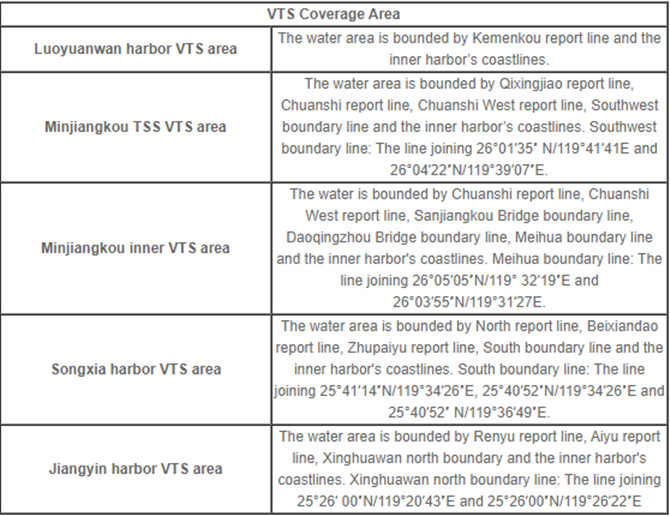 2.1.2 Report Lines and Points
2.1.2 Report Lines and Points
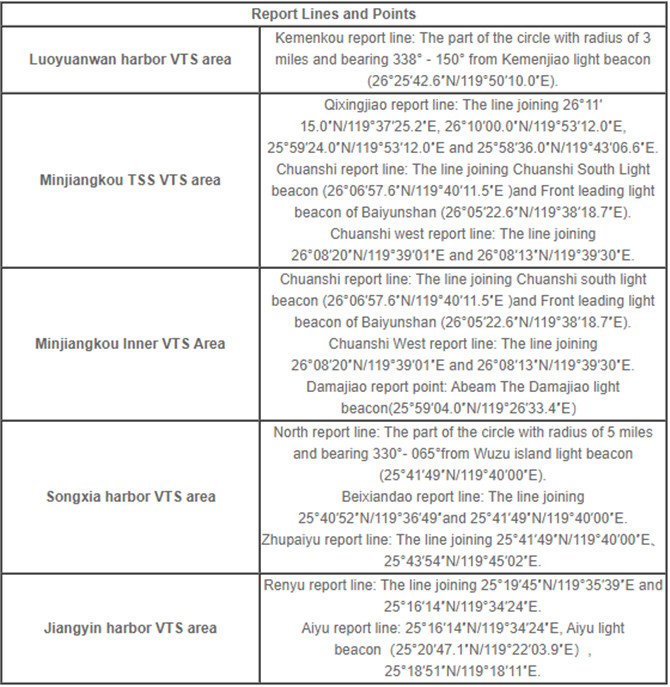 2.1.3 VHF Channel
Fuzhou VTS sectors and VHF working channels as follows:
2.1.3 VHF Channel
Fuzhou VTS sectors and VHF working channels as follows:
 Vessels should call Fuzhou VTS and maintain a continuous listening on the appropriate VHF channel.
2.2. Xiamen Port
2.2.1 VTS Coverage Area
Xiamen VTS area is bounded by Southeast report line, East report line, North line, West report line and the inner harbor’s coastlines.
North line: The line joining 24°32′48″N/118°09′30″E and 24°34′12″N/118°11′18″E.
2.2.2 Report Lines and Points
(1) Southeast report line: The part of the circle with radius of 12 nautical miles and bearing 055°- 230°from Zhenhaijiao lighthouse (24°16′09″N/118°07′54″E).
(2) East report line: The part of the circle with radius of 3.5 nautical miles and bearing 045°- 150° from the point (24°30′00″N/118°12′00″E).
(3)West report line: The line joining 24°28′02″N/117°56′55″E, 24°26′00″N/117°56′55″E, 24°26′00″N/118°00′00″E and 24°24′34″N/118°00′00″E.
(4) Qingyu lighthouse report line: The line joining 24°21′12″N/118°06′12″E and 24°24′33″N/118°13′14″E.
(5) Tuyu report point: Abeam Tuyu island (24°27′12″N/118°11′18″E).
(6) North line: The line joining 24°32′48″N/118°09′30″E and 24°34′12″N/118°11′18″E.
2.2.3 VHF Channel
Sectors and VHF channels are as follows:
1. Sector Working channel:
Xiamen VTS outer harbor area VHF CH67
Xiamen VTS inner harbor area VHF CH08
2. Other port user channels:
Distress, safety and calling channel VHF CH16
Xiamen VTS follow-up working channel VHF CH27
Safety message broadcast channel VHF CH12
Pilot station working channel VHF CH06
Given the above, owners are suggested to pay attention to the above adjustment when passing through coastal area and calling ports of Fujian province to ensure compliance with the requirement of reporting to VTS, in order to avoid any delay or penalty to the ship. Meanwhile, owners are also recommended to double check with local agent when necessary.
Vessels should call Fuzhou VTS and maintain a continuous listening on the appropriate VHF channel.
2.2. Xiamen Port
2.2.1 VTS Coverage Area
Xiamen VTS area is bounded by Southeast report line, East report line, North line, West report line and the inner harbor’s coastlines.
North line: The line joining 24°32′48″N/118°09′30″E and 24°34′12″N/118°11′18″E.
2.2.2 Report Lines and Points
(1) Southeast report line: The part of the circle with radius of 12 nautical miles and bearing 055°- 230°from Zhenhaijiao lighthouse (24°16′09″N/118°07′54″E).
(2) East report line: The part of the circle with radius of 3.5 nautical miles and bearing 045°- 150° from the point (24°30′00″N/118°12′00″E).
(3)West report line: The line joining 24°28′02″N/117°56′55″E, 24°26′00″N/117°56′55″E, 24°26′00″N/118°00′00″E and 24°24′34″N/118°00′00″E.
(4) Qingyu lighthouse report line: The line joining 24°21′12″N/118°06′12″E and 24°24′33″N/118°13′14″E.
(5) Tuyu report point: Abeam Tuyu island (24°27′12″N/118°11′18″E).
(6) North line: The line joining 24°32′48″N/118°09′30″E and 24°34′12″N/118°11′18″E.
2.2.3 VHF Channel
Sectors and VHF channels are as follows:
1. Sector Working channel:
Xiamen VTS outer harbor area VHF CH67
Xiamen VTS inner harbor area VHF CH08
2. Other port user channels:
Distress, safety and calling channel VHF CH16
Xiamen VTS follow-up working channel VHF CH27
Safety message broadcast channel VHF CH12
Pilot station working channel VHF CH06
Given the above, owners are suggested to pay attention to the above adjustment when passing through coastal area and calling ports of Fujian province to ensure compliance with the requirement of reporting to VTS, in order to avoid any delay or penalty to the ship. Meanwhile, owners are also recommended to double check with local agent when necessary.
Source:HUATAI
The opinions expressed herein are the author's and not necessarily those of The Xinde Marine News.
Please Contact Us at:
admin@xindemarine.com




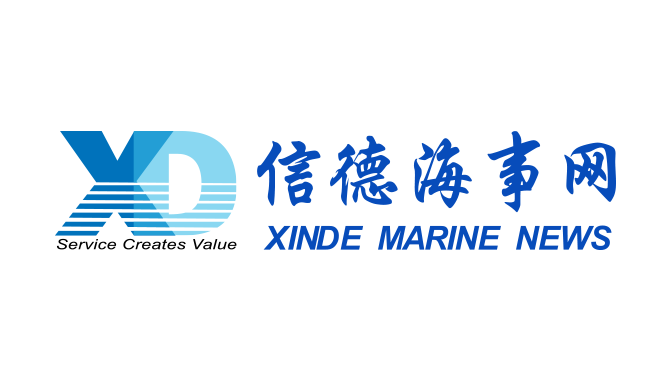 Reporting Requirements for Foreign-flagged Ships En
Reporting Requirements for Foreign-flagged Ships En 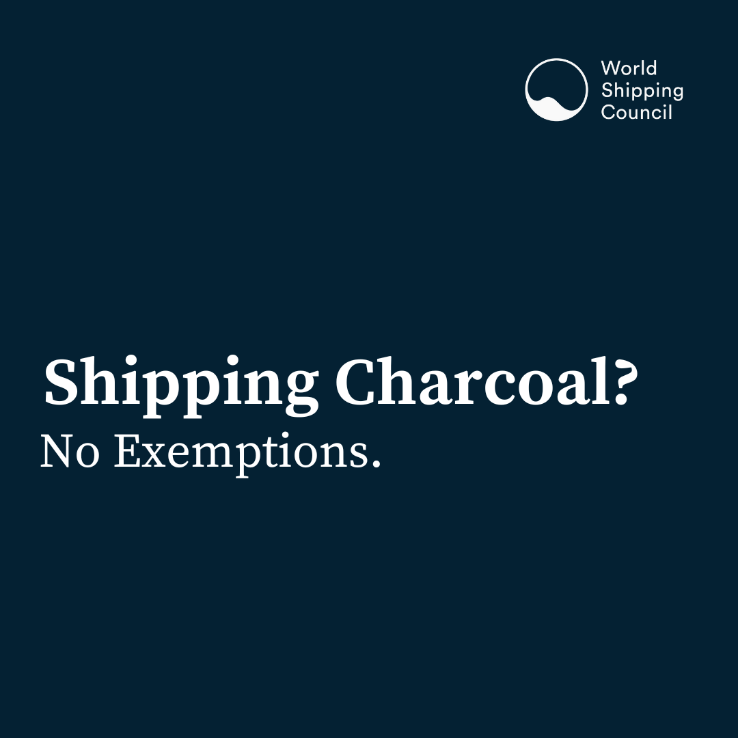 Shipping Carriers Move to Prevent Deadly Charcoal F
Shipping Carriers Move to Prevent Deadly Charcoal F  KR, HD KSOE, HD HHI, KSS Line, and Liberian Registr
KR, HD KSOE, HD HHI, KSS Line, and Liberian Registr 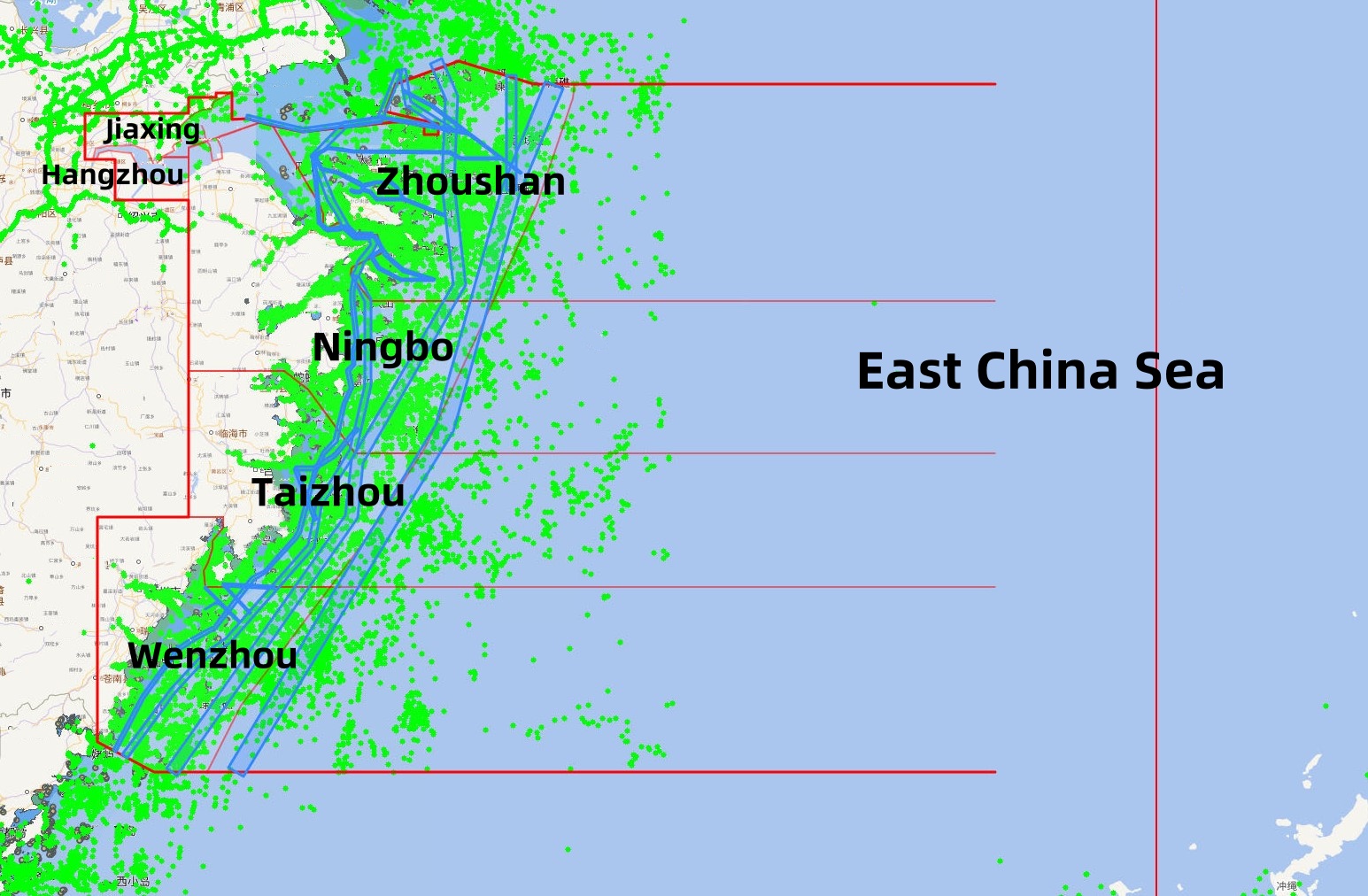 Zhejiang Maritime Safety Administration Issues the “
Zhejiang Maritime Safety Administration Issues the “  RightShip Updates Age Trigger for Vessel Inspection
RightShip Updates Age Trigger for Vessel Inspection 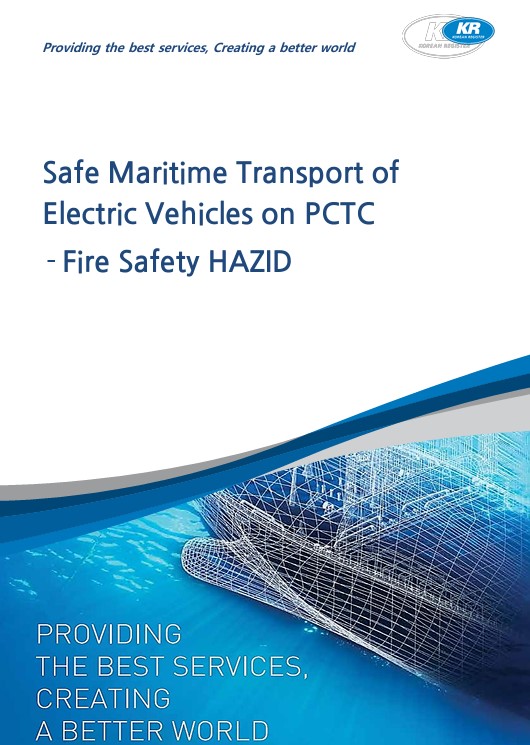 KR Publishes Report on Safe Maritime Transport of E
KR Publishes Report on Safe Maritime Transport of E